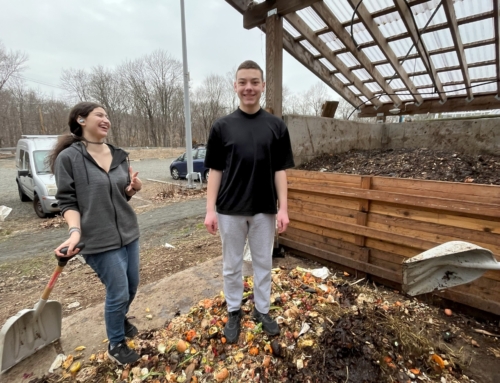By Mark Loalbo – Site and Facilities Manager
Before we begin…it is important to recognize that maple sugaring is an indigenous tradition that precedes the colonization of North America. We are grateful to the people who hold and have held this knowledge for generations and who shared it (willingly or not) so that we, too, can enjoy syrup from the trees here at Common Ground.
 Sap dripping from a tap, sap boiling in the evaporator, and our “Sugar Shack” with smoke stack billowing!
Sap dripping from a tap, sap boiling in the evaporator, and our “Sugar Shack” with smoke stack billowing!
Each sugaring season is unique, and this one is certainly no exception. Many people ask – when do we start tapping trees? When we start tapping varies each year depending on the weather – and this year’s fluctuating temperatures made it a challenging decision. A few weeks ago it was -3 degrees outside and a day later we were almost at 50, making it almost impossible to say, “Well now’s a good time!” Sugaring requires a freeze thaw cycle, which typically starts in February and runs through March. When temperatures dip below freezing at night and warm up into the 40s during the day, the sap runs steadily and drips at a nice tempo. If temperatures are too high, the sap will run fast and then come to a screeching halt, which happened this year unfortunately! If that doesn’t make you think about global warming maybe you should!
We need 40+ gallons of sap to make one gallon of syrup, so a constant supply of fresh sap is needed to keep the process going. As we boil down the sap in our evaporator, we need to add more to get the correct sugar content for syrup.
There are many stories on how Native Americans and indigenous peoples discovered maple sap. I recently listened to a talk by Darlene Kascak, a Native American storyteller and Educational Coordinator at The Institute for American Indian Studies in Washington, Connecticut (or Quinnetukut as it was named by the Algonkian tribes.) She told how Native Americans would watch squirrels nibbling at certain trees in the winter. They soon realized the squirrels were eating the sap dripping out of the trees. Native Americans in the Northeast would collect the sap, put it into hollowed out logs, then add red hot stones to cook the sap. When colonizers arrived, they gleaned from Native Americans how to harvest the sap. They also brought with them iron cauldrons which could be hung over an open fire, and sap could be boiled longer until it turned into a thick sweet syrup.
There is much prep to do prior to lighting the evaporator and set up for educating the Nature Year tours, students and the families that come through during Maple Fest. We clean and set up the sugar shack and stock it with needed items: split wood, kindling, and necessary utensils. The evaporator has to be cleaned and leveled, and the taps and tubes sterilized. The stove pipe was cleaned in the fall, and the order for glass bottles was placed early so as not to miss out due to the dreaded “supply chain issues.”

CG high school students washing collection buckets. Hot sap flowing off the evaporator.
Sugaring is a team effort! This year, CG high school students Frank, Charlie, Ava, and Jonathan washed out all the collection buckets which was a huge help. They also stacked firewood in the sugar shack. Nature year educators David, Cjet, Morgan, Alex, Kaylee, Sylvia, Veronica and the rest have been helping by splitting kindling wood and tending the evaporator which needs a constant eye on the fire in the arch and a healthy supply of sap in the flu pan. Keith Riley’s “How Things Work” students also pitched in by learning to fire the evaporator and help moving split logs.
With the mild, wild weather this year, sap collection has been an issue. The flow from our trees has been sluggish – even Elinor, our best tree, has been a bit miserly! However, the snowfall late in February was like a shot in the arm to the trees. We collected nearly 40 gallons of sap in two days following the snow storm! If the temperature cycles as it should, we could be in for a better than expected season – maybe a bumper crop!! But now we are presented with another issue: with that much sap we will have to find cold storage as it can spoil if left out too long. Fortunately we have the farm coolbot and Chef Thiya’s refrigerator. Who knows, maybe winter still has more cold and snow up its sleeve!
This past week, with the help of Jason, CG’s new Maintenance Manager, I bottled up our first batch. The yield was impressive – almost 50 small bottes and 3 large ones! That’s plenty for our Mobile Market & Farm Share communities and there was even enough left over for Chefs Thiya, Antoine and Waleska to use for pancakes or waffles in our cafeteria!
Here’s to a sweet end to winter! Enjoy!
Mark







Leave A Comment